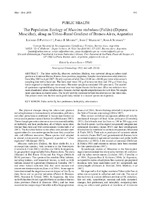Please use this identifier to cite or link to this item:
http://sgc.anlis.gob.ar/handle/123456789/374| DC Field | Value | Language |
|---|---|---|
| dc.contributor.author | Patitucci, Luciano D. | es |
| dc.contributor.author | Mulieri, Pablo R. | es |
| dc.contributor.author | Mariluis, Juan C. | es |
| dc.contributor.author | Schnack, Juan A. | es |
| dc.date.accessioned | 2012-11-20T03:13:45Z | - |
| dc.date.available | 2012-11-20T03:13:45Z | - |
| dc.date.issued | 2010 | - |
| dc.identifier.issn | 1519-566X | - |
| dc.identifier.uri | http://sgc.anlis.gob.ar/handle/123456789/374 | - |
| dc.identifier.uri | http://www.scielo.br/pdf/ne/v39n3/v39n3a20.pdf | - |
| dc.description | Fil: Patitucci, Luciano D. ANLIS Dr.C.G.Malbrán. Centro Nacional de Diagnóstico e Investigación en Endemo-Epidemias; Argentina. | es |
| dc.description | Fil: Mulieri, Pablo R. ANLIS Dr.C.G.Malbrán. Centro Nacional de Diagnóstico e Investigación en Endemo-Epidemias; Argentina. | es |
| dc.description | Fil: Mariluis, Juan C. ANLIS Dr.C.G.Malbrán. Centro Nacional de Diagnóstico e Investigación en Endemo-Epidemias; Argentina. | es |
| dc.description | Fil: Schnack, Juan A. Consejo Nacional de Investigaciones Científicas y Técnicas (CONICET); Argentina. | es |
| dc.description.abstract | The false stable fly, Muscina stabulans (Fallen), was surveyed along an urban-rural gradient at Almirante Brown, Buenos Aires province, Argentina. Samples were taken at monthly intervals from May 2005 to April 2007. Hourly captures of adult flies (10:00 am - 04:00 pm) were taken at each sampling date with a hand net. The baits used were 250 g of rotten cow liver and 250 g of fresh dog faeces exposed in shaded and sunny areas. The entire sample accumulated 358 specimens. The number of specimens captured during the second year was higher than in the first year. Muscina stabulans was more abundant at urban-suburban sites. Females showed significant preferences for cow liver. We caught more specimens in shaded areas. The hourly activity increased toward the afternoon at the three sites. The present work was the first ecological study related to a muscid species in Argentina. | es |
| dc.format | application/pdf | ES |
| dc.language.iso | en | es |
| dc.publisher | Springer | es |
| dc.relation.ispartof | Neotropical entomology | es |
| dc.rights | info:eu-repo/semantics/openAccess | en_US |
| dc.source | Neotropical Entomology 2010; 39(3): 441–446 | en_US |
| dc.subject | Urbanización | es |
| dc.subject | Dípteros | es |
| dc.subject | Muscidae | es |
| dc.subject | Argentina | es |
| dc.subject | Buenos Aires | es |
| dc.title | The population ecology of muscina stabulans (fallen) (Diptera : Muscidae), along an urban-rural gradient of Buenos Aires, Argentina | es |
| dc.type | Artículo | es |
| dc.coverage | ARG | en_US |
| dc.coverage | Buenos Aires | en_US |
| anlis.essnrd | 1 | es |
| item.openairetype | Artículo | - |
| item.cerifentitytype | Publications | - |
| item.languageiso639-1 | en | - |
| item.fulltext | With Fulltext | - |
| item.openairecristype | http://purl.org/coar/resource_type/c_18cf | - |
| item.grantfulltext | open | - |
| crisitem.author.dept | Administración Nacional de Laboratorios e Institutos de Salud “Dr. Carlos G. Malbrán” (ANLIS) | - |
| crisitem.author.dept | Administración Nacional de Laboratorios e Institutos de Salud “Dr. Carlos G. Malbrán” (ANLIS) | - |
| Appears in Collections: | snrd Publicaciones CeNDIE | |
Files in This Item:
| File | Description | Size | Format | |
|---|---|---|---|---|
| NeotropicalEntomology,2010,39(3),441–446.pdf | Artículo en inglés | 177.56 kB | Adobe PDF |  View/Open |
Page view(s)
175
checked on Dec 20, 2025
Download(s)
75
checked on Dec 20, 2025
Google ScholarTM
Check
Items in DSpace are protected by copyright, with all rights reserved, unless otherwise indicated.

